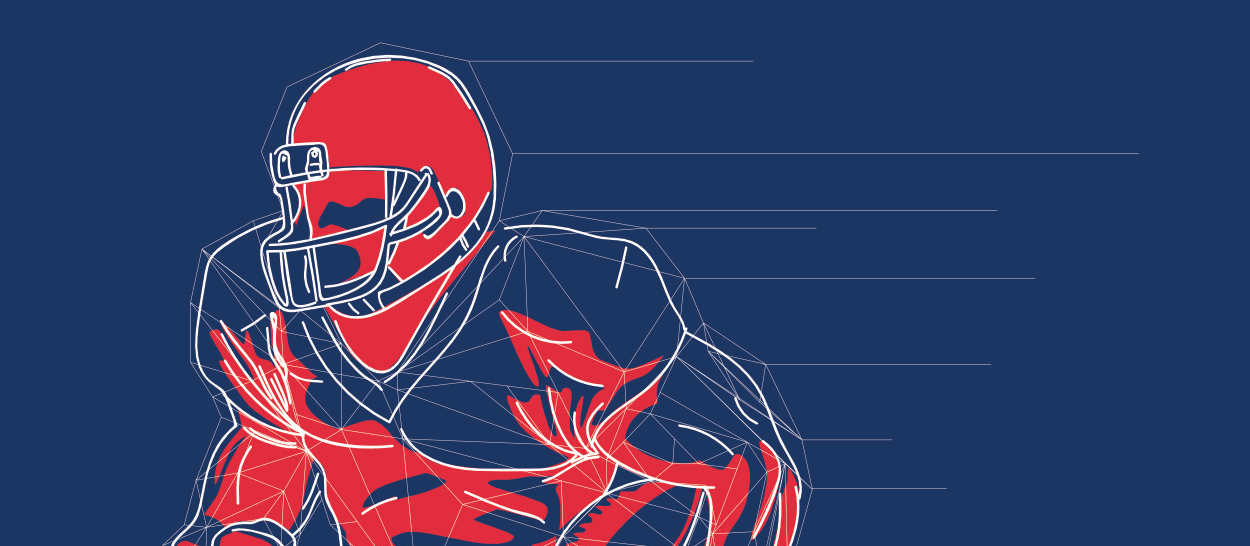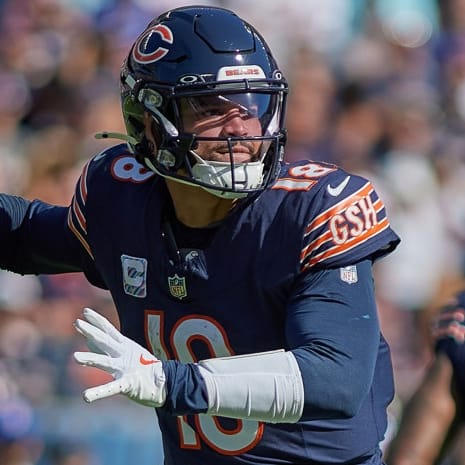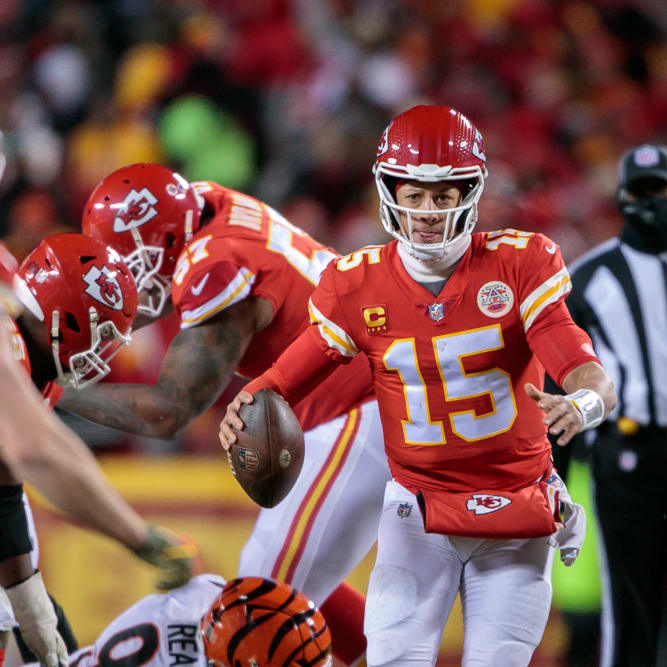This article is part of our NFL Offseason Watch series.
Now that the developments of the NFL Combine have sunk in, and everyone's had time to chew on what they've seen and heard, it's time to make rough sketches of the fantasy prospects who might appear in the top half of the draft.
Unfortunately for fantasy football owners, it looks like this draft will be heavy in positions that rarely make rookie impacts (quarterback, wide receiver) and diluted at the position we lean on for immediate impact (running back). There's a chance that not a single runner will go in the first round, and a significant number of the draft's top backs project mostly to running back-by-committee roles.
Still, as we see every year, injuries and team politics can cause the unexpected, thrusting previously unknown players into featured roles. Runners like Jerome Harrison, Peyton Hillis, Arian Foster and Jamaal Charles were all considered situational players at one point, yet all proved top fantasy producers at various points. As the running back position becomes increasingly cloudy in the NFL, it's more important than ever to familiarize yourself with the talents of other so-called situational runners waiting for their time to come. The obscure names often become the most important.
That's not to say you shouldn't worry about quarterbacks or receivers. Even though they're raw, quarterbacks like Cam Newton, Jake Locker and Colin Kaepernick could prove useful as rookies due to their running abilities. Even if their teams suffer, 10 rushing yards per point means those three could yield
Now that the developments of the NFL Combine have sunk in, and everyone's had time to chew on what they've seen and heard, it's time to make rough sketches of the fantasy prospects who might appear in the top half of the draft.
Unfortunately for fantasy football owners, it looks like this draft will be heavy in positions that rarely make rookie impacts (quarterback, wide receiver) and diluted at the position we lean on for immediate impact (running back). There's a chance that not a single runner will go in the first round, and a significant number of the draft's top backs project mostly to running back-by-committee roles.
Still, as we see every year, injuries and team politics can cause the unexpected, thrusting previously unknown players into featured roles. Runners like Jerome Harrison, Peyton Hillis, Arian Foster and Jamaal Charles were all considered situational players at one point, yet all proved top fantasy producers at various points. As the running back position becomes increasingly cloudy in the NFL, it's more important than ever to familiarize yourself with the talents of other so-called situational runners waiting for their time to come. The obscure names often become the most important.
That's not to say you shouldn't worry about quarterbacks or receivers. Even though they're raw, quarterbacks like Cam Newton, Jake Locker and Colin Kaepernick could prove useful as rookies due to their running abilities. Even if their teams suffer, 10 rushing yards per point means those three could yield nice spot starts along the way.
The receivers, in contrast to the running backs, possess a good amount of star power this year, so a Year One impact for at least a few rookies is hardly out of the question. A.J. Green and Julio Jones are the obvious standouts in this regard -- both look like top-10 picks and stand an excellent chance to start right away for their next employers.
Below are post-Combine rankings and projected landing ranges for the draft's top offensive talents.
QUARTERBACK
1. Cam Newton, Auburn (6-5, 248)
Grade: First overall
The film from last year confirmed the most important traits with Newton -- it was obvious long before he arrived in Indianapolis that he had the arm strength, mechanics, accuracy and athleticism to be an NFL quarterback. Given that, it would have taken a monumental flop for him to fall out of the top five. He did not orchestrate any such feats, and he's steadily picking up steam as he makes his case to the Carolina Panthers at the first pick. If he does land in Carolina, Jimmy Clausen wouldn't hold him off for long, if at all. If you're the gambling type, get ready to rank Newton high in your dynasty cheatsheets, because it's been a while since the NFL saw a quarterback with this much potential. Of course, it's also been a while since an NFL quarterback prospect was such a headline magnet, which some believe can't be a good sign.
2. Blaine Gabbert, Missouri (6-4, 234)
Grade: Top five
Gabbert elected to not participate in the Combine's throwing drills, which means the spotlight will be solely on him when the Missouri Pro Day comes around March 17. What he did engage in at the Combine, however, benefited his stock. He reportedly came off well in interviews, and his 40-yard dash time of 4.62 seconds was highly impressive, though probably not a reliable indicator of his on-field speed (he runs a bit more like a 4.75 guy). While it's not out of the question for Gabbert to go first overall, it looks like he'll settle somewhere between three and five, with eight being his doomsday scenario.
3. Ryan Mallett, Arkansas (6-7, 253)
Grade: Top 40
He might not be a skilled public speaker, but that's not what NFL teams would be paying him for, anyway. Mallett can sling it better than anyone in the draft, and even with his character concerns, that's a very big deal. It simply won't be easy for a team with a non-West Coast offense to shrug off Mallett's passing abilities. His 5.37-second 40-yard dash at the Arkansas Pro Day will make some freak out, but it's not as if Mallett is a Drew Bledsoe or Vinny Testaverde in the pocket.
4. Jake Locker, Washington (6-3, 231)
Grade: First round
Although it's no longer fashionable to be a Locker advocate, he's still safely locked into the first round. Smart, fast quarterbacks with big arms simply aren't easy to ignore (see: Newton, Gabbert). A lot of fuss has been made over his accuracy, but he'd have looked more accurate in college if he had played for a more competitive program. While the Jake Plummer comparisons may be fair for him, Locker has some Donovan McNabb in him, too. And he's not as wild as Plummer was.
5. Scott Tolzien, Wisconsin (6-2, 212)
Grade: Fifth or sixth round
Yeah, I'm Tolzien's agent. I'm well aware that he's considered a late-round pick, but I just have to be missing something about the guy. Despite his slightly sidearm delivery and lack of size and arm strength, I am entirely confident he'll at least be a good backup for a playaction-heavy, Jim Harbaugh-style offense. When I watch him, I see a poor man's Troy Aikman. Maybe that means he's Jason Garrett? Even if that's all he is, there's something to be said for a quarterback who's a legitimately good backup. He's accurate on short and intermediate routes, he's smart, he's tough, he's a good leader, he's got great character and he started two years in a pro-style system. I just don't know how all that can't mean something to some team. Ranking him this high isn't an indictment against Christian Ponder or Colin Kaepernick, both of whom will get drafted far earlier than Tolzien. But Tolzien's getting badly overlooked.
The next five:Christian Ponder (Florida State, top 40), Colin Kaepernick (Nevada, top 50), Ricky Stanzi (Iowa, third or fourth round), Andy Dalton (TCU, third or fourth round), Greg McElroy (Alabama, fourth or fifth round)
RUNNING BACK
1. Mikel Leshoure, Illinois (6-0, 227)
Grade: Top 40
Leshoure and Mark Ingram are pretty much 1A and 1B, so the distinction between the two is slight. I'm going with Leshoure at the one spot, though, basically because he has more upside. He's a bit reminiscent of Jonathan Stewart, though slightly less athletic with much better pass-catching ability. Leshoure is one of the few runners in this draft who clearly presents feature back potential in the NFL.
2. Mark Ingram, Alabama (5-9, 215)
Grade: Top 40
The "can't miss" label should almost never be applied, but Ingram has a remarkably high floor. He's entirely pro ready, and he's a natural, instinctive runner. You know you'll be getting something if you draft him. Of course, you also know you won't be getting an Adrian Peterson or Chris Johnson, so there won't be any rush to draft him in the top half of the first round.
3. Johnny White, North Carolina (5-10, 209)
Grade: Third round
Surprisingly, White is actually picking up a good amount of hype lately. Even though his playing time at North Carolina was brief and he lacks brilliant athleticism, White's not someone you want to tackle, and that's evident on film. His balance might be second to none in the draft, and he runs with violence reminiscent of Marion Barber's glory days. He's also a naturally gifted receiver, which will help him as he tries to make the case that he's a three-down player.
4. DeMarco Murray, Oklahoma (6-0, 213)
Grade: Top 50
It's hard not to be impressed with Murray after his superb college career and strong performance at the Combine. Durability questions remain, but a team looking for a complementary runner has to love how Murray fits. He's the best receiver to show up at running back in some time, so he offers offensive coordinators more playcalling flexibility than the typical NFL back. Owners in PPR dynasty leagues should keep a close eye on this one.
4. Ryan Williams, Virginia Tech (5-9, 213)
Grade: Top 50
Despite his lack of impressive physical tools, Williams is in the running with Ingram as the draft's most instinctive runner. He definitely looks better on the field than he does in a workout setting. He's a little like Felix Jones with his ability to glide into new directions without losing velocity -- he rarely loses the steam he builds up as he navigates through traffic. That's a subtle trait, but it's often the difference between a short run and a long one. Even though Williams only has high 4.5 speed, his ability to hold his momentum through directional changes makes him more elusive than most 4.3 guys. He's a potential feature back in the NFL.
The next five:Jordan Todman (Connecticut, second or third round), Kendall Hunter (Oklahoma State, second or third round), Daniel Thomas (Kansas State, second through fourth rounds), Derrick Locke (Kentucky, second or third round), Shane Vereen (California, second or third round)
WIDE RECEIVER
1. A.J. Green, Georgia (6-4, 211)
Grade: Top six
Green didn't have to do much at the Combine to remind that he's the top receiver in the draft, but he put on a nice showing, anyway. A 40-yard dash of 4.5 flat at his size was perfectly in line with expectations, and essentially voided any paranoia that Green didn't have the jets to play in the NFL. Some are suggesting Julio Jones' impressive Combine showing pushed him ahead of Green, but it's not likely.
2. Julio Jones, Alabama (6-3, 220)
Grade: Top 10
Jones might have had the single most impressive Combine performance, not just receivers. A 40-yard dash in the high 4.3s was the highlight, and he did that running on a stress fracture. Still, while Jones deserves credit for making such a great showing, he simply does not play that fast. He doesn't look any faster than Green on the field, and it'd be odd if any GMs decided to go with a stopwatch time in a track setting rather than game film. Still, stranger things have happened.
3. Torrey Smith, Maryland (6-1, 204)
Grade: First round
Smith had a fine showing at the Combine, with unofficial 40-yard dash times between 4.35 and 4.43 seconds. The game film always showed that Smith had jets, but putting it on the stopwatches should make teams a bit more comfortable about the idea of investing a first-round pick in the versatile Maryland star. He also showed a highly impressive 41-inch vertical jump. Smith's draft stock is a bit in the air due to the lack of a clear demand for wideouts in the top half of the first round, but there's still a chance he cracks the top 20.
4. Randall Cobb, Kentucky (5-10, 191)
Grade: Top 45
The do-everything Kentucky star surprised most when he timed at 4.46 at the Combine, as most figured he wasn't quite that athletic. With the stopwatch on his side, Cobb has a pretty decent shot at sneaking into the first round. Cobb should especially appeal to organizations that are big on character, as he is well established as one of the more competitive college football players in recent memory. He is not to be doubted.
5. Jon Baldwin, Pittsburgh (6-4, 228)
Grade: Top 40
There are still questions to be answered about his route running, acceleration and ability to change direction, but Baldwin has mostly done well for himself to this point in the draft process. His 4.50-range 40-yard dash wasn't quite as good as some had hoped from the big-play specialist, but it's still well above average. Moreover, he topped all wideouts with a 42-inch vertical at the Combine. He has a good chance at landing in the first round.
The next five:Leonard Hankerson (Miami, top 40), Jerrel Jernigan (Troy, second round), Titus Young (Boise State, second round), Greg Salas (Hawaii, second or third round), Aldrick Robinson (SMU, third or fourth round)
TIGHT END
1. Kyle Rudolph, Notre Dame (6-6, 259)
Grade: Top 40
Rudolph more than likely will be the first tight end drafted, and he probably couldn't screw it up if he tried. He didn't run at the Combine, but he'll presumably do fairly well for himself when he runs at the Notre Dame Pro Day on April 7. His combination of strength and athleticism make him the prototypical tight-end prospect, with the belief being that he'll eventually develop into a three-down tight end. If he hadn't had durability issues in college, he'd probably be talked about as a top-20 pick instead of a top-40 one.
2. Lance Kendricks, Wisconsin (6-3, 243)
Grade: Second round
Kendricks' 40-yard dash time in the mid 4.7s would be fine if he weighed more than 250 pounds, but running in that range at 243 was a bit disappointing for the former wideout. There are legitimate concerns about whether he'll be a successful blocker in the NFL at his relatively light weight, and he'll be hounded by the dreaded "h-back" label from here. He might project best into a quick-strike offense like the Colts', where fellow undersized tight ends Dallas Clark and Jacob Tamme turned out OK.
3. Virgil Green, Nevada (6-3, 249)
Grade: Second through fourth rounds
His 40-yard dash time of 4.64 wasn't blistering, but Green's 42.5-inch vertical at the Combine was, on the other hand, highly impressive. That type of explosiveness screams potential as a receiver in the NFL. Two players right with him are Jordan Cameron of USC and Rob Housler of Florida Atlantic. Which of the three might emerge on top is anyone's guess, but they're similar prospects. Green might have the upper hand, though, as he has a lot of experience playing in Nevada's run-heavy offense, while the others don't have as much experience blocking.
4. Jordan Cameron, USC (6-5, 254)
Grade: Third through fifth rounds
Cameron is probably more raw than Green, but he might have more upside, too. The former BYU basketball player only really played tight end one season at USC, trying his hand at receiver before that. His production was minimal in his one year as a starter for USC, catching just 16 passes for 126 yards and a touchdown, but at least he got experience playing as a traditional tight end during the year.
5. Rob Housler, Florida Atlantic (6-5, 248)
Grade: Third through fifth rounds
Playing basically as a wide receiver in Florida Atlantic's unusual spread offense, Housler probably has just about everything to learn as a blocker. Still, you have to believe at least a few teams are willing to invest in him, as he has potential. He led all tight ends with a 4.55-second 40-yard dash at the Combine, so a move to receiver probably isn't out of the question, either. He can probably be useful for any imaginative offensive coordinator looking for a receiver.
The next five:D.J. Williams (Arkansas, third through fifth rounds), Luke Stocker (Tennessee, third or fourth round), Schuylar Oordt (Northern Iowa, fourth through sixth rounds), Zack Pianalto (North Carolina, fourth through seventh rounds), Lee Smith (Marshall, fifth through seventh rounds)










